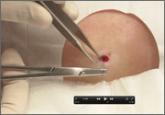The family physician (FP) noted that the lesions were centered on hair follicles and diagnosed bacterial folliculitis. She prescribed doxycycline 100 mg twice daily for 14 days.
On follow-up, the rash hadn’t improved, so the FP suggested a punch biopsy and the patient consented to the procedure. This time, the FP prescribed 0.1% triamcinolone cream and hydroxyzine for the itching, as the diagnosis was uncertain. The biopsy revealed that the patient had eosinophilic folliculitis, a condition mostly seen in immunosuppressed individuals, including those with HIV/AIDS.
Eosinophilic folliculitis associated with HIV is treated with highly active antiretroviral therapy (HAART) as well as one or more of the following: topical steroids, antihistamines, itraconazole, metronidazole, nonsteroidal anti-inflammatory drugs, oral retinoids, or ultraviolet light therapy.
When the patient returned for a follow-up visit, the FP noted considerable improvement that was likely due to the restart of his HAART therapy and use of the topical steroid and antihistamine. The FP encouraged the patient to call for an appointment if the eosinophilic folliculitis didn’t resolve completely.
Photos and text for Photo Rounds Friday courtesy of Richard P. Usatine, MD. This case was adapted from: Usatine R, Hunter-Anderson K. Folliculitis. In: Usatine R, Smith M, Mayeaux EJ, et al, eds. Color Atlas of Family Medicine. 2nd ed. New York, NY: McGraw-Hill; 2013:680-685.
To learn more about the Color Atlas of Family Medicine, see: www.amazon.com/Color-Family-Medicine-Richard-Usatine/dp/0071769641/
You can now get the second edition of the Color Atlas of Family Medicine as an app by clicking on this link: usatinemedia.com
